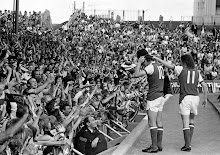
This article featured in the 200th Anniversary edition of the Gooner magazine in November
http://www.onlinegooner.com/covers/index.php?id=200
The history of the Football League Cup has always been a chequered one. A laughing stock in Football circles from its inception in 1960, until moving the final to Wembley and the promise of a place in Europe had raised its profile by the end of that decade. The height of its importance came after Heysel when it became one of only three possible trophies to win, Arsenal's victorious campaign in 1987 with two goals from Charlie Nicholas (below) in the final against the then mighty Liverpool had spearheaded the longest period of success for Arsenal in the modern era. On 11th November 1998 however came the start of a long cold winter for the cup with three handles. As Arsenal lined up to play Chelsea at Highbury, in a rematch of the previous season’s Semi Final, their side had deliberately consisted of mere second stringers who were subsequently ripped to sheds 5-0 by the visiting holders. There had been much outcry from many Arsenal fans that had shelled out almost £100 to bring their families to Highbury for what they had believed would be a star studded and competitive London derby. In the years that followed the League Cup would fail to be box office.
The rapid expansion of the Champions League at the end of the nineties had meant that both domestic cups would fall lower in the pecking order. While the FA Cup’s importance would be demoted to that which the League Cup previously held, the League Cup in turn looked doomed to a Zenith Data Systems Cup style irrelevance. The sneer of the ‘Joka-Cola Cup’, soon to be followed by that of the ‘Worthless Cup’ meant that the competition had gone full circle back to its original standing in 1960 as the trophy that no-one seemed too bothered about.
In November 2001, back in the heady days of the Wenger-Ferguson Premiership duopoly, Arsenal had been drawn at home to an equally disdainful Manchester United. An Arsenal fan at work had asked me if I wished to buy her ticket as she was otherwise engaged, I declined. By the end of the day after failing to find anyone interested enough to actually pay money to watch this game, she came back to me and asked if I wanted it for free, to which I accepted. It may not be an exaggeration to say that had this ticket been nailed to a wall in an alleyway passers by may have been more inclined to steal the nails. Arsenal ran out 4-0 winners on the night, however despite witnessing Arsenal’s biggest win over United since 1970 at the time it didn’t feel a particularly note worthy victory and hasn’t ever been seen as such since.
Fast forward eight years on from the irrelevance of that 4-0 victory over a fellow Champions League side, the recent Liverpool clash ( http://www.youtube.com/watch?v=Rg7svJebmlI) had been witnessed by a 60,000 capacity crowd and had sold out quicker than most of the weekend premiership matches at Arsenal so far this season. Though the £10 ticket price is a big factor, as is the considerable southern fan base of the opposition, there is also the belief that this once derided competition is worth watching again due to the Wengerite philosophy of using the tournament as a showcase for up and coming talent. The turning point for the competition had come during the 2003/04 campaign, as ‘the invincibles’ of the first team took the Premiership by storm, in the Carling Cup debuts were awarded to future first stringers Gael Clichy and Cesc Fabregas. From hereafter Arsenal would achieve 8 quarter final appearances on the bounce with virtually a reserve/youth team, putting to the sword several formidable Premiership opposition sides in the process.
A contributory factor to the trophy void that has emerged over the last five seasons could well be not taking this trophy as seriously as other sides do, however the Carling Cup has built for itself a portfolio of great moments during that time. Such moments in that portfolio include the time the kids mashed the Spuds after going two down at the Lane, Baptista tearing Liverpool apart at Anfield (http://www.youtube.com/watch?v=_zJFOci1CqY&feature=related) and debuts and first goals for several of today’s regular squad members and key players. It is also much noted how distinctive Carling Cup night is from any regular match night, be it at Highbury or the new Home of Football in Holloway. Mexican waves aside on Carling Cup night our architecturally great stadium feels like it has the kind of atmosphere it was built for, as opposed to the soulless bowl it has come to be seen as due to a continuation of the ‘Highbury Library’ vibe.
While the FA Cup’s adaptation to Footballing modernity rapidly feels like a competition that has lost an empire and yet to find a role, the Carling Cup in contrast seems to be enjoying a whole new lease of life and is indeed once again box office. Despite the exception of the 5-1 mauling at White Hart Lane in the 2007/08 campaign and possibly seeing Cheryl Tweedy’s husband glee the year before after Chelsea survived a first half onslaught by the Young Guns, it is still the case that exiting the Carling Cup is a lesser blow than losing a game in the either of the other two cup competitions or in the Premiership. However the words ‘Joka-Cola Cup’ and ‘Worthless Cup’ seem to pop up far less frequently than they used to. In fact such is the joy that has emanated from this competition over the last few years, if I may be so bold I’d like to propose the moniker ‘Darling Cup’ for future reference.



No comments:
Post a Comment